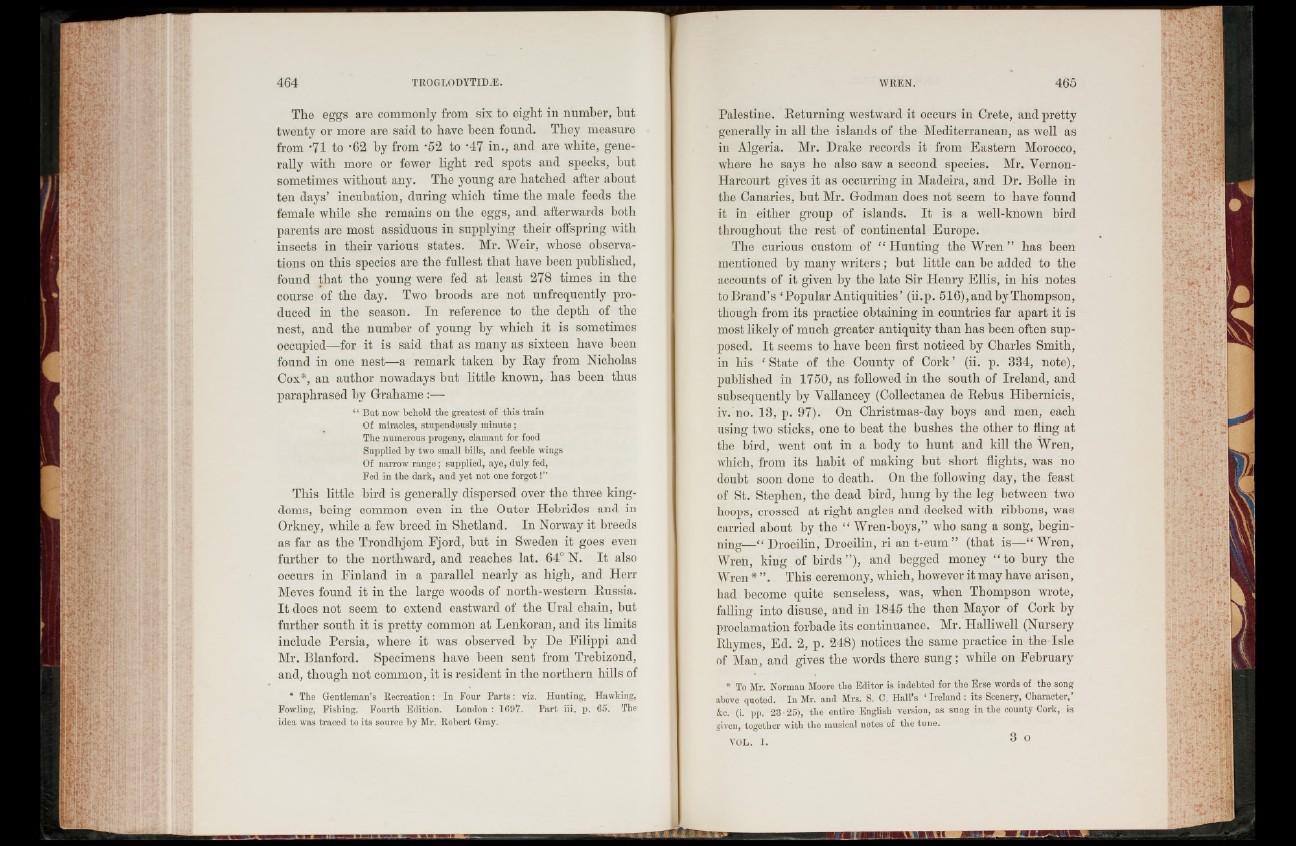
The eggs are commonly from six to eight in number, but
twenty or more are said to have been found. They measure
from -71 to -62 by from -52 to -47 in., and are white, generally
with more or fewer light red spots and specks, but
sometimes without any. The young are hatched after about
ten days’ incubation, during which time the male feeds the
female while she remains on the eggs, and afterwards both
parents are most assiduous in supplying their offspring with
insects in their various states. Mr. Weir, whose observations
on this species are the fullest that have been published,
found that, the young were fed at least 278 times in the
course of the day. Two broods are not unfrequently produced
in the season. In reference to the depth of the
nest, and the number of young by which it is sometimes
occupied—for it is said that as many as sixteen have been
found in one nest—a remark taken by Ray from Nicholas
Cox*, an author nowadays but little known, has been thus
paraphrased by Grahame:—
“ But now behold the greatest of this train
Of miracles, stupendously minute;
The numerous progeny, clamant for food
Supplied by two small bills, and feeble wings
Of narrow range; supplied, aye, duly fed,
Fed in the dark, and yet not one forgot!”
This little bird is generally dispersed over the three kingdoms,
being common even in the Outer Hebrides and in
Orkney, while a few breed in Shetland. In Norway it breeds
as far as the Trondlijem Fjord, but in Sweden it goes even
further to the northward, and reaches lat. 64° N. I t also
occurs in Finland in a parallel nearly as high, and Herr
Meves found it in the large woods of north-western Russia.
I t does not seem to extend eastward of the Ural chain, but
further south it is pretty common at Lenkoran, and its limits
include Persia, where it was observed by De Filippi and
Mr. Blanford. Specimens have been sent from Trebizond,
and, though not common, it is resident in the northern hills of
* The Gentleman’s Recreation: In Four P a rts : viz. Hunting, Hawking,
Fowling, Fishing. Fourth Edition. London : 1697. Part iii. p. 65. The
idea was traced to its source by Mr. Robert Gray.
Palestine. Returning westward it occurs in Crete, and pretty
generally in all the islands of the Mediterranean, as well as
in Algeria. Mr. Drake records it from Eastern Morocco,
where he says he also saw a second species. Mr. Vernon-
Harcourt gives it as occurring in Madeira, and Dr. Bolle in
the Canaries, but Mr. Godman does not seem to have found
it in either group of islands. I t is a well-known bird
throughout the rest of continental Europe.
The curious custom of “ Hunting the Wren ” has been
mentioned by many writers; but little can be added to the
accounts of it given by the late Sir Henry Ellis, in his notes
to Brand’s ‘Popular Antiquities’ (ii.p. 516), and by Thompson,
though from its practice obtaining in countries far apart it is
most likely of much greater antiquity than has been often supposed.
I t seems to have been first noticed by Charles Smith,
in his ‘ State of the County of Cork’ (ii. p. 384, note),
published in 1750, as followed in the south of Ireland, and
subsequently by Vallancey (Collectanea de Rebus Hibernicis,
iv. no. 13, p. 97). On Christmas-day boys and men, each
using two sticks, one to beat the bushes the other to fling at
the bird, went out in a body to hunt and kill the Wren,
which, from its habit of making but short flights, was no
doubt soon done to death. On the following day, the feast
of St. Stephen, the dead bird, hung by the leg between two
hoops, crossed at right angles and decked with ribbons, was
carried about by the “ Wren-boys,” who sang a song, beginning—“
Droeilin, Droeilin, ri an t-eum ” (that is—“ Wren,
Wren, king of b ird s”), and begged money “ to bury the
Wren * ” . This ceremony, which, however it may have arisen,
had become quite senseless, was, when Thompson wrote,
falling into disuse, and in 1845 the then Mayor of Cork by
proclamation forbade its continuance. Mr. Halliwell (Nursery
Rhymes, Ed. 2, p. 248) notices the same practice in the Isle
of Man, and gives the words there sung; while on February
* To Mr. Norman Moore the Editor is indebted for the Erse words of the song
above quoted. In Mr. and Mrs. S. C. Hall’s ‘ Ireland : its Scenery, Character,’
&c. (i. pp. 23-25), the entire English version, as sung in the county Cork, is
given, together with the musical notes of the tune,
VOL. I . 3 °
t ill Mi l . .\AJ_Y U